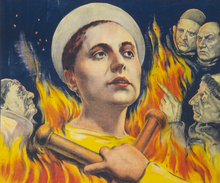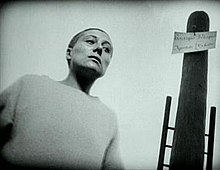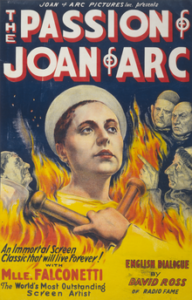The Passion of Joan of Arc [La Passion de Jeanne d’Arc] ***** (1928, Maria Falconetti, Eugene Silvain, André Berley) – Classic Movie Review 10,819
Danish director Carl Theodor Dreyer’s landmark 1928 French black and white silent historical film The Passion of Joan of Arc, depicting her trial and execution, had a bumpy ride to the screen, and was a huge financial flop but was a major critical success and is considered one of the greatest films ever made. It is based on the record of Joan’s trial and stars stage actress Maria Falconetti in her only major film role as Joan in a performance that has become legendary. Its lucky survival in its original form is only by the skin of its teeth.
The Société Générale des Films invited Dreyer to make a film in France and he chose Joan of Arc as a subject because of her renewed popularity with the French. It was meant to be respectful but it turned out to be a risky choice. Dreyer wrote the script with Joseph Delteil after spending more than a year researching the martyr and the transcripts of her trial.
The Passion of Joan of Arc is shot on one huge concrete set at Boulogne-Billancourt, Hauts-de-Seine, France, modelled from medieval architecture to portray the Rouen prison realistically. The film is renowned for its pioneering cinematography, concentrated use of startling close-ups and striking camera angles (even digging holes in the set to achieve low camera angles). Dreyer would not allow the actors to use make-up and used lighting designs to make the actors look more grotesque.
Falconetti was 35 when she played the 19-year-old Joan but her portrayal is widely considered one of the more astonishing performances committed to film. It has been claimed that her performance was the result of extreme cruelty by Dreyer, a notoriously demanding director who pushed her to the brink of emotional collapse. However, such stories are based only on rumour.
The film was immediately controversial because of French nationalists’ scepticism whether a Danish director could make a film about one of France’s most revered historical icons. Later, Dreyer’s film was cut after objections by the Archbishop of Paris and the government censors. Dreyer angrily accused the Société Générale of mutilating the film to avoid offending Catholic viewers and sued it for breach of contract. The lawsuit went on till 1931 when Dreyer started another film.
Its huge financial flop caused the Société Générale to cancel its contract with Dreyer. And it was banned in Britain for its portrayal of crude English soldiers who mock and torment Joan in scenes mirroring biblical accounts of Roman soldiers mocking Christ.
It was released and viewed in various re-edited versions attempting to restore Dreyer’s original cut until in 1981 a print of Dreyer’s final cut was discovered in a closet of the Gaustad Hospital, a mental institution in Oslo, Norway. The film was sent to the Norwegian Film Institute where it was found to be a copy of the original 1928 version with Danish intertitles, and it was re-released. Uncensored prints were shipped to Copenhagen, and were not censored there, making the discovered print the definitive version. Runtime: utes.
All current DVD versions of the film use Richard Einhorn’s ‘Voices of Light’ for musical accompaniment.
Falconetti suffered from mental illness all her life, and she died in Buenos Aires, Argentina, in 1946, aged 54, an apparent suicide by a restrictive diet.
Carl Theodor Dreyer died on 20 March 1968, aged 79. His other best known films include Michael (1924) Vampyr (1932), Day of Wrath (1943), Ordet (1955), and Gertrud (1964).
Also in the cast are Eugène Silvain as Bishop Pierre Cauchon, André Berley as the prosecutor Jean d’Estivet, Maurice Schutz as the canon Nicolas Loyseleur, Antonin Artaud as the Dean of Rouen Jean Massieu, Gilbert Dalleu as the Vice-InquisitorJean Lemaitre, Jean d’Yd as Nicolas de Houppeville, Louis Ravet as Jean Beaupère, Camille Bardou as the English Captain in Rouen Lord Warwick, and Michel Simon.
© Derek Winnert 2021 Classic Movie Review 10,819
Check out more reviews on http://derekwinnert.com




